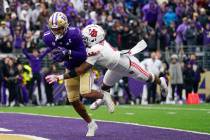Pushing limits tests athletes’ health
Mark Philippi has kids as young as 9 walking into his sports institute in Las Vegas, athletes of all shapes and sizes wanting to improve their level of fitness. To become bigger, stronger, faster, leaner, more agile, more flexible, more coordinated, more balanced, more everything.
“Most kids start now in the seventh and eighth grade and some even younger so they are that much further ahead when getting to high school,” Philippi said. “It’s the idea that you have to be physically developed younger and younger. There is a pressure to be that much more intense, to train that much harder and push yourself more and more. The bar has been raised.
“I’m not even saying I agree with it, but it’s the way athletics are now.”
Philippi knows well and respects the strength and conditioning coaches at the University of Iowa, a place where on the weight room wall is scripted: “Hard work beats talent when talent doesn’t work hard.” He is also a former strength coach at UNLV who has never seen the sort of story that is playing out in Iowa City.
Iowa officials on Thursday vowed a thorough investigation into what caused 13 football players to be hospitalized with an unusual muscle disorder after offseason workouts, to determine the cause of 13 seemingly healthy young men suffering from symptoms of soreness throughout the body and tea-colored urine, 13 college athletes today who are being treated for rhabdomyolysis — a fancy word that means torn muscles and that can frequently result in kidney damage.
I know what you’re thinking.
The S-word.
A bizarre story like this isn’t going to break without being surrounded by at least a small cloud of suspicion into the use of steroids or other performance-enhancing drugs. But most experts say you don’t see rhabdomyolysis with anabolic steroids or growth hormones.
All 13 players tested negative for illegal drugs, but officials couldn’t confirm whether any or all were taking supplements.
Philippi has another theory, one that could be attached to most college programs nationally and many at the prep level: That those players at Iowa — trained in a way to keep changing and improving methods, to accelerate progress and create different and better results — for whatever reason had a poor reaction to what was being asked of them over a short period of time.
There were several reports Friday that the workouts — which included players being timed performing 100 squats at half their weight capability before pushing sleds — were the players’ first since a three-week layoff after the Insight Bowl and allegedly came with a strength coach telling them that because the team failed to finish games enough in 2010, “We’ll find out who wants to be here.”
Yep. Welcome to big-time college athletics.
“I’ve written some pretty intense workouts for athletes through the years and have never had something like this happen,” Philippi said. “It’s definitely unusual and raises some red flags.
“But the people at Iowa are pretty cutting-edge as far as training and testing and rehabilitation. It’s ironic this happened at a place so respected across the country, a place known for being very, very knowledgeable and proactive.”
You can’t define coach Kirk Ferentz by the latter, not when he remained on the road for two days after learning of his players being hospitalized. He eventually made it home and into a den of anger from parents of the 13 who found it odd Ferentz would continue pursuing other kids while theirs were going through a battery of tests, with reports of some gaining 30 to 50 pounds as fluids were being pumped into their bodies and one sustaining kidney damage that might be permanent.
Ferentz reportedly stood there and took all of the fuming and emotional remarks, which he should. He didn’t speak publicly about the players until Friday, which falls somewhere between incredibly embarrassing and outright absurd.
Gary Barta, the school’s athletic director, had been, as of Friday, just as pathetically quiet as his head coach.
You get the feeling those at Iowa haven’t yet totally grasped what happened and why, but the need and pressures surrounding college football programs and their players to always be bigger and stronger than the next opponent has been as much a part of the game the last decade as inequitable streams of bowl revenue.
“In general, you’re always trying something different that might produce different results,” Philippi said. “Iowa is known for taking good players and making them into great ones. A big part of that is the strength and conditioning program, and maybe this time they tried things they haven’t done before to shake it up or get an edge.”
What they got was 13 kids in hospital beds hoping their torn muscles recover and kidneys perform at a normal level. Suddenly, finishing games better seems a pretty empty pursuit.
Las Vegas Review-Journal sports columnist Ed Graney can be reached at egraney@reviewjournal.com or 702-383-4618. He can be heard from 2 to 4 p.m. Monday and Thursday on “Monsters of the Midday,” Fox Sports Radio 920 AM.
IOWA PLAYERS’ CONDITION MIRRORS 2007 CASE IN S.C.IOWA CITY, Iowa — Iowa football players hospitalized with a muscle disorder this week could have been pushing their bodies too hard after a break, which is apparently what happened to seven South Carolina swimmers who came down with the same ailment in 2007, a doctor involved in the earlier case said Friday.
Rupert Galvez, a Denver doctor who specializes in sports medicine, helped treat the South Carolina swimmers as a medical fellow and wrote a 2008 paper about their case in the Clinical Journal of Sports Medicine warning coaches to avoid the same problem with rigorous workouts after extended layoffs.
Like the 13 Iowa football players, the swimmers had rhabdomyolysis, which involves the release of muscle fibers into the bloodstream and can cause kidney damage. Extreme physical exertion is one of several causes of the disorder.
The Iowa players checked into the hospital Monday after complaining of discolored urine and extreme soreness. All of them had participated in intense workouts that began last week after the players returned from winter break. Coach Kirk Ferentz said five of the players were discharged Friday.
THE ASSOCIATED PRESS


















